![]()
![]()
![]()
Use LEFT and RIGHT arrow keys to navigate between flashcards;
Use UP and DOWN arrow keys to flip the card;
H to show hint;
A reads text to speech;
27 Cards in this Set
- Front
- Back
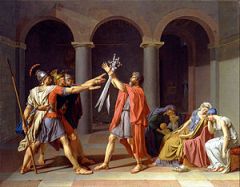
Oath of the Horatii
Jacques-Louis David, French artist |
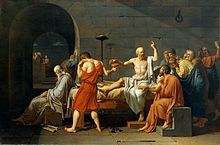
Death of Socrates
Jacques-Louis David, French artist |
|
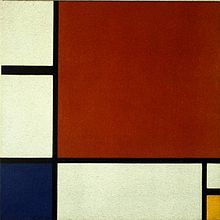
Piet Mondrian,
Composition II in Red, Blue, and Yellow, 1930 Neo-Plasticism. Founded by Mondrian, this is a strict form of abstract art allowing only rectangles and straight lines. |
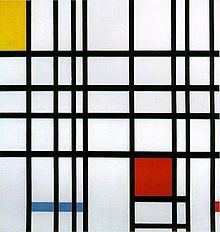
Piet Mondrian,
Composition with Yellow, Blue, and Red, 1937–42, oil on canvas Neo-Plasticism. Founded by Mondrian, this is a strict form of abstract art allowing only rectangles and straight lines. |
|
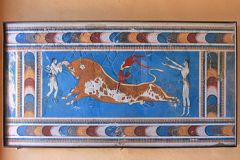
True fresco, or buon fresco, involves painting on the plaster as it is drying, which provides a relatively permanent seal.
Reconstruction of one of the Taureador frescos. Late Minoan period. |

However, such technique requires great speed and skill, as a large area must be completed before the plaster hardens.
(close up of Taureador fresco) Although they were frescos, they were painted on stucco relief scenes and therefore are classified as plastic art. |
|
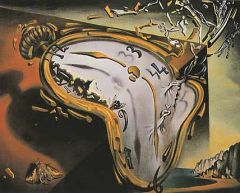
Clock Explosion
Spanish surrealist painter, Salvador Dali |
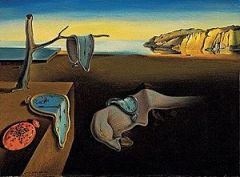
Persistence of Memory by Salvadore Dali.
It epitomizes Dalí's theory of "softness" and "hardness", which was central to his thinking at the time. |
|
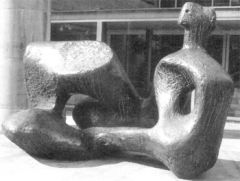
Henry Moore.
His forms are usually abstractions of the human figure, typically depicting mother-and-child or reclining figures. Moore's works are usually suggestive of the female body, apart from a phase in the 1950s when he sculpted family groups. His forms are generally pierced or contain hollow spaces. |
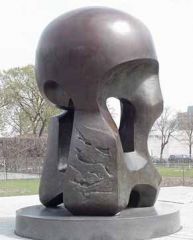
Moore is known for his abstract sculptures with curved edges and massive forms.
|
|

Hans Memling’s Adoration of the Magi (1479)
Triptych: 3 panel painting. |
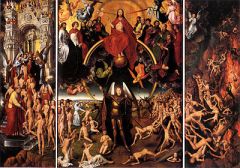
Hans Memling: German-born painter who moved to Flanders and worked in the tradition of Early Netherlandish painting.
|
|
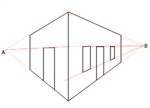
Andrea dal Pozzo (1647-1709) was particularly known for his converging perspective, with parallel lines coming in from each corner and seeming to meet in the center.
|

Andrea Pozzo, Italian Jesuit Brother, Baroque painter and architect, decorator, stage designer, and art theoretician.
He was best known for his grandiose frescoes using illusionistic technique called quadratura, in which architecture and fancy are intermixed. His masterpiece is the nave ceiling of the Church of Sant'Ignazio in Rome. Through his techniques, he has become one of the most remarkable figures of the Baroque period. |
|
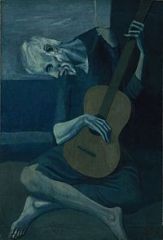
The Old Guitarist
Pablo Picasso's Blue Period One of the first to use Cubism. The Old Guitarist recalls the style of El Greco. |
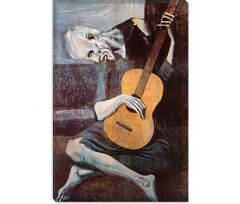
At the time of The Old Guitarist’s creation, Modernism, Impressionism, Post-Impressionism, and Symbolism had merged and created an overall movement called Expressionism, which greatly influenced Picasso’s style
|
|
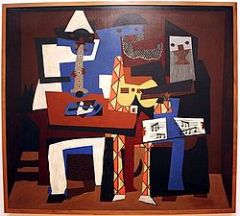
Pablo Picasso, Three Musicians (1921)
Originally done almost exclusively in blacks, whites, and grays, the abstract cubist forms were designed to appeal to the human intellect. By the 1920s, cubism took on more colors and represented less images of nature. |
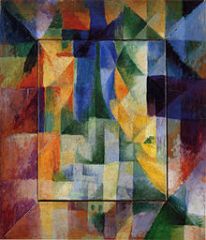
Simultaneous Windows on the City by Robert Delaunay: example of Abstract Cubism
|
|

Crucifixion and Last Judgment
diptych by Hubert van Eyck |

Diptych of Martin van Nieuwenhoven
diptych by Hans Memling |
|
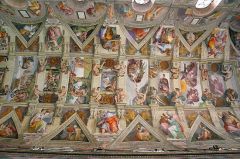
The Sistine Chapel ceiling, painted by Michelangelo between 1508 and 1512,
is a cornerstone work of High Renaissance art. Central to the ceiling decoration are nine scenes from the Book of Genesis, of which the Creation of Adam is the best known. Created: 1508–1512 Period: High Renaissance Media: Plaster, Gold |
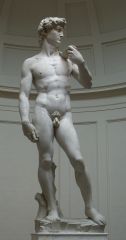
David is a masterpiece of Renaissance sculpture created between 1501 and 1504, by the Italian artist Michelangelo.
It is a 5.17-metre marble statue of a standing male nude. Media: Carrara marble Created: 1500–1504 Subject: David Periods: Italian Renaissance, Renaissance |
|

Donatello (1386-1466) was a Renaissance artist born in Florence, Italy.
He was famous for his artwork in bas relief, a type of shadow relief sculpture. |
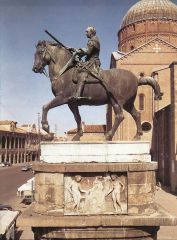
Artist: Donatello
Year: 1453 Medium: Bronze Height: 134 in (340 cm) Location: Piazza del Santo, Padua, Italy The Equestrian statue of Gattamelata is an early piece that made its way in during the Italian Renaissance. The statute depicts Erasmo de Narni, who served under the Republic of Venice. His death in 1443 sparked his family to request for a sculpture to be made in his honor, and it was the first Renaissance equestrian statute that was displayed at the time. |
|
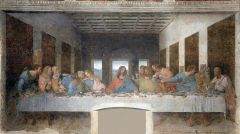
Da Vinci was someone who was skilled and knowledgeable in many, many subjects, including science, mathematics, music, and most importantly, art. He was the epitome of a Renaissance man if there never was one.
The Last Supper, by Leonardo da Vinci, is one of the most famous works of art in the world. It is a large fresco style painting on the wall of Santa Maria delle Grazie, Milan, Italy. It is not a true fresco, because it was painted on a dry wall, instead of wet plaster. |
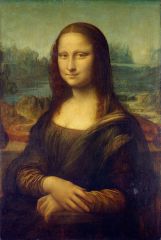
The Mona Lisa was painted by the Leonardo Da Vinci, the famous Italian artist, between 1504 and 1519,
and is a half body commission for a woman named Lisa Gherardini. The Mona Lisa is an oil painting, with a cottonwood panel as the surface. It is unusual in that most paintings are commissioned as oil on canvas, but the cottonwood panel is part of what has attributed to the fame of the painting. |
|
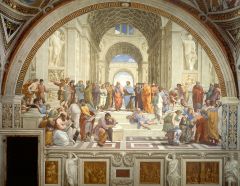
School of Athens is one of a series of four frescoes painted by Raphael representing branches of knowledge.
Raphael Sanzio (1483-1520): Better known as just Raphael, an Italian architect and painter of the High Renaissance. He was best known for the perfection and grace in his artwork. Raphael was considered a master |
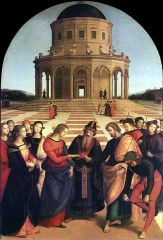
The Marriage of the Virgin is part of an altarpiece created for a church at Citta di Castello, Italy and shows the marriage of the Virgin Mary and St. Joseph.
The painting, an oil on panel, was completed in 1504 and is an example of Raphael’s increasing maturity and confidence as an artist. His colors here are vibrant, and the faces of his characters are specific and full of calm. |
|
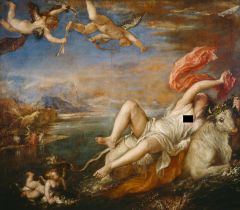
The Rape of Europa
Tiziano Vecillio (Titian) was a high Italian renaissance painter born to a family of moderate means in 1488 and living in the Venice mountains. He received his tutelage through the workshop of Giovanni Bellini; the most prominent artist in 15th century Venice. The painting depicts a completely surprised Europa arms and legs flailing as she is carried away on Jupiter’s back as he is disguised as an ornamented white bull while a little chubby and nude boy riding the back of a dolphin appears to be mocking her. Meanwhile in the sky are cupids follow the happy scene. |
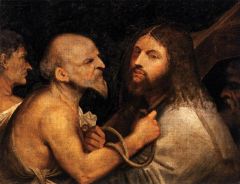
Around the year 1508 or 1509, the master Renaissance painter Titian painted an oil painting that is known as Christ Carrying the Cross.
The oil painting is that it was said to have miraculous curative abilities, having been written about in many historical narratives. The overall mood of the work is somber and dark. The brightest colors are dull flesh-tones, and the palette is dominated by various shades of brown. Against an almost black background, Christ is shown in semi-profile carrying the cross on his shoulder |
|
|
Italian Renaissance Artists
|
Donatello (1386-1466)
Sandro Botticelli (1445-1510) Leonardo da Vinci (1452-1519) Michelangelo Buonarroti (1475-1564) Raphael Sanzio (1483-1520) Titian (1488-1576) |
|
|
Northern Renaissance Artists
|
Albrecht Durer (1471-1528)
El Greco (1541-1614) |
|
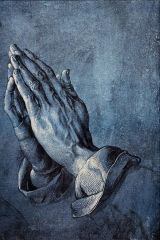
Albrecht Durer (1471-1528) was an important Northern Renaissance man from Germany.
He was prominent in painting, printmaking, mathematics, engraving, and theory. Praying Hands by Albrecht Dürer is a famous ink and pencil drawing created in the early 14th century. he drawing is on blue colored paper that the artist made himself. Praying Hands is part of a series of sketches that Dürer drew for an altarpiece. |
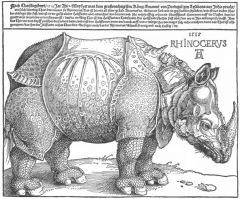
Artist: Albrecht Dürer
Year: 1515 Medium: Woodcut After the fall of the Roman Empire, Asian animals previously imported for circuses and gladitorial events became scarce or non-existent in Western Europe. In 1515 A.D., King Manuel of Portugal received a rhinocerous from his ambassador in Cambay. The animal had several different homes before drowning in a shipwreck. Dürer never saw the actual rhinocerous but worked from a sketch done by another artist. |
|
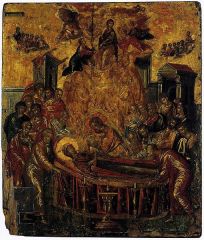
El Greco (1541-1614) was a Spanish Renaissance artist of Greek descent.
He became a master in Post-Byzantine art before moving to Rome. In Italy, his style was embellished with components of Venetian Renaissance and Mannerism.. In Dormition of the Virgin, El Greco combined Italian Mannerist, and post-Byzantine styles and iconographic elements. Medium: Tempera and gold on panel. It was not known that El Greco painted Dormition of the Virgin, until 1983, when curators discovered his signature at the base of the candelabrum, located at the bottom, center of the painting. |
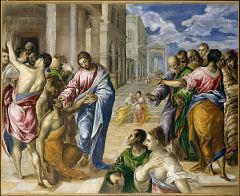
The Miracle of Christ Healing the Blind (oil on canvas).
El Greco always signed his works with his Greek name of Domenikos Theotokopoulos. |
|
|
Baroque Artists
|
Caravaggio (1571-1610)
Peter Paul Rubens (1577-1640) Gian Lorenzo Bernini (1598-1680) Rembrandt Harmenszoon van Rijn (1606-1669) |
|
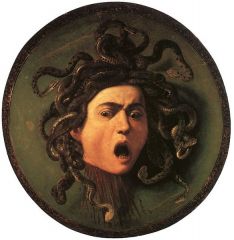
Artist: Caravaggio
Year: 1597 Medium: Oil on canvas mounted on wood Caravaggio, from Milan, Italy, was a part of the Baroque art movement. He was commissioned to paint Medusa as a gift for the Grand Duke of Tuscany, to be placed in the Medici collection in Florence. Caravaggio was a pioneer in Italian Baroque style, which grew out of the Mannerist art movement. Italian Baroque was very similar to Italian Renaissance, yet the color palette was darker, and richer, and themes of religion were more popular. |
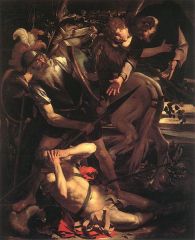
The Conversion of Saint Paul
Medium: Oil on cypress wood Created between 1600 and 1601, this conversion, like the Cerasi Chapel painting, uses Caravaggio’s trademark light and dark or chiaroscuro technique to depict a busy, historical and event. Caravaggio was an artist of the Baroque style, which emerged out of Mannerism. With the threat of Protestantism, the Roman Catholic Church sought for new art. Caravaggio’s radical naturalism and dramatic style offered them what they thought they needed. |
|
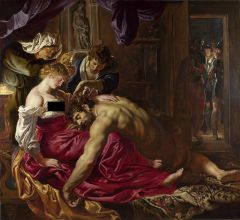
Peter Paul Rubens was a Baroque painter who specialized in painting color, sensuality, and movement. He was famous for many Counter-Reformation artworks.
Artist: Peter Paul Rubens Year: 1609-1610 Medium: Oil on wood |
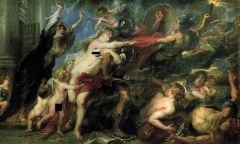
Consequences of War
(in a style that art historians call “Flemish Borque.”) Artist: Peter Paul Rubens Year: 1638–39 Medium: Oil on canvas Location: Palazzo Pitti, Florence The Roman god of war, Mars, takes center stage in the Consequences of War. He stands astride with sword in hand, held low, but which is pointing toward a chaotic scene of battle. His head is turned sharply backward as he gazes upon a gorgeous nude depiction of Venus, the goddess of love. Her head is resting on the back shoulder of Mars. Her face seems to plead with him to end the madness he has brought among mankind. |
|
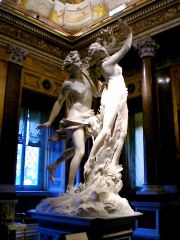
The life sized sculpture of Apollo and Daphne is a hand carved statue that was created by Gian Lorenzo Bernini.
Artist: Gian Lorenzo Bernini Year: 1622–25 Medium: Marble Gian Lorenzo Bernini was an Italian artist who was skilled in sculpting, architecture, playwriting, stage-setting, and painting. His abilities as a sculptor set him apart from other artists of his age. |
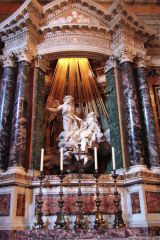
The Ecstasy of Saint Teresa is a white marble sculpture that was created by Gian Lorenzo Bernini.
Medium: Marble The sculpture was commissioned by a Venetian Cardinal and was completed in 1652. |
|

Self-Portrait (Altman) by Rembrandt van Rijn.
Artist: Rembrandt Year: 1660 Medium: Oil on canvas Rembrandt’s artworks gave way to what historians refer to as the Dutch Golden Age. Rembrandt was an excellent painter and etcher, one of the greatest in European art history. Rembrandt was 54 when he painted the portrait. At the time, his life was in turmoil. He had fallen out of favor with many critics and sponsors. His reputation was in tatters and all his pupils had abandoned him. He was also in dire financial straits, mainly due to extravagant spending in the past, and had even had to sell his home. |
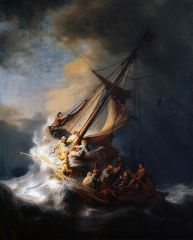
The Storm on the Sea of Galilee is a painting from 1633 by the Dutch Golden Age painter Rembrandt van Rijn that was in the Isabella Stewart Gardner Museum of Boston, Massachusetts, United States, prior to being stolen on March 18, 1990.
The painting depicts the miracle of Jesus calming the waves on the Sea of Galilee, as depicted in the fourth chapter of the Gospel of Mark in the New Testament of the Christian Bible. It is Rembrandt's only seascape. It is widely believed, because of the fourteen people in the boat, that Rembrandt painted himself in the boat along with the twelve disciples and Jesus. |
|
|
Donatello was a Renaissance artist born in Florence, Italy.
He was famous for his artwork in bas relief, a type of shadow relief sculpture. |
Italian Renaissance Artists - Donatello (1386-1466):
St. Mark Zuccone The Feast of Herod David Equestrian Monument of Gattamelata Judith and Holofernes |
|
|
Botticelli was an Italian painter of the Early Renaissance. He hailed from Florence, Italy.
|
Italian Renaissance Artists - Botticelli (1445-1510):
Fortitude Adoration of the Magi The Birth of Venus Primavera Cestello Annunciation St. Augustine Venus and Mars Mystical Nativity Temptation of Christ |
|
|
Da Vinci was someone who was skilled and knowledgeable in many, many subjects, including science, mathematics, music, and most importantly, art.
He was the epitome of a Renaissance man, if there never was one. |
Italian Renaissance Artists - Leonardo da Vinci (1452-1519):
The Last Supper Mona Lisa Vitruvian Man The Baptism of Christ Annunciation Lady with an Ermine Ginevra de’ Benci Adoration of the Magi St. Jerome in the Wilderness |

